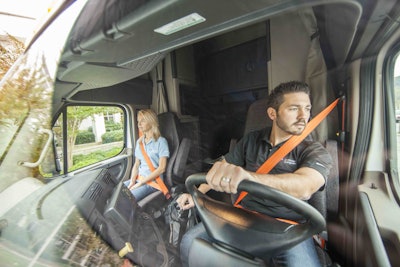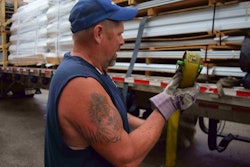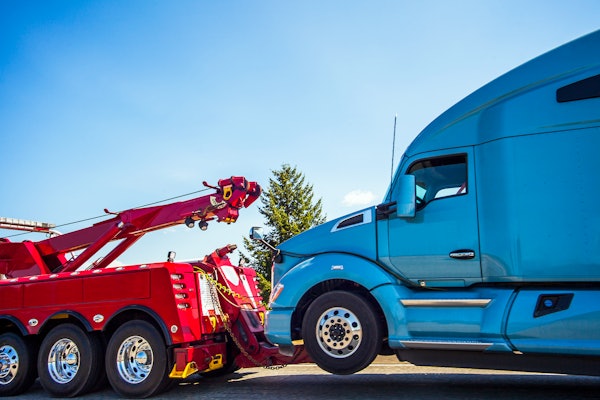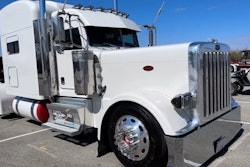 Hazmat-certified team owner-operators at Covenant enjoy 100 percent no-touch freight, bonus opportunities and other benefits.
Hazmat-certified team owner-operators at Covenant enjoy 100 percent no-touch freight, bonus opportunities and other benefits.Covenant Transport has distinguished itself largely through its team driving emphasis, and its leadership sees good potential to capitalize further on that asset.
The company has about 900 teams and 375 solo drivers. About 90 of the trucks are owner-operated. For hazmat-certified owner-operators, the team opportunities include 100 percent no-touch freight, $1.03 per mile, a safety bonus, a $1,000 monthly bonus to each team that runs 15,000 miles, and other benefits.
The team advantage has been most evident recently with e-commerce freight and organic food, said senior executives I met with during a visit to the Chattanooga, Tenn., headquarters.
Though the company has long valued teams, its current focus and market position has evolved greatly in the last two decades. CTG grew too quickly between 1997 and 2000, from 1,600 trucks to 4,000, said Joey Hogan, president of holding company Covenant Transportation Group. Then the recession hit, and the company struggled until 2010.
Prior to 2011, when the company developed a comprehensive strategic plan, its team operation was used largely as a “just-in-time inventory system around manufactured goods,” where the value added wasn’t all that critical, said Richard Cribbs, CTG executive vice president and chief financial officer.

“We had to price accordingly,” he said. “What we should’ve been competing with was air freight.”
Now Covenant is hauling lots of freight for Amazon and less-than-truckload carriers like FedEx and UPS. With the LTL contracts, Covenant often transports consolidated shipments long-haul, and the LTL receiver breaks down the shipment for distribution. Team operations can meet deadlines acceptable to these customers, but solo drivers can’t, he said.
Today’s customer expectations for online ordering are that the item will be on the doorstep within two or three days, Hogan said. Team drivers can often compete with air freight to make that happen.
“The shipping company wants no surprises,” he said. “Our view is over the next two to three years, if you’re in the e-commerce space of any retailer, it will require a team.”
The expedited factor is critical with Fresh Express salads and Delta Airlines’ fleet maintenance, two of the largest customers handled by one of CTG’s other subsidiaries, Covenant Transport Solutions, its brokerage and third party logistics business, Hogan says. The organic produce market, which is growing 10 percent to 12 percent annually, requires expedited delivery because of the products’ shorter shelf life. Other customers include Walmart, Taylor Farms and Ready Pac.
One challenge with the evolution of Covenant’s team operations is a trend toward shorter hauls. “Years ago, teams didn’t want short hauls like 1,000 miles,” which often amounted to one load per day, Hogan said. Now it’s more acceptable, with some teams even averaging two loads per day.
Covenant is looking at alternate forms of compensation, perhaps performance-based, to ensure that its teams are well paid. The company now offers 52 cents to 56 cents per mile for teams, which is roughly 30 percent more than solo pay.
A year ago, eight out of 10 applicants for team work at Covenant did not come with a partner, Hogan said. That’s now seven of 10, and getting close to six. That trend is a huge benefit for helping smooth out the bumps of trying to successfully match individuals as teams. When family members come in as a team, they’re “gold,” he said. They get priority in training and the best trucks.
In addition to the inherent speed of team operations, Covenant has also enhanced delivery times by focusing on weather in its routing. Following a few years of excessive weather-related accidents early in the last decade, the company began a program to expand winter driving training, to gather more weather data, and to be more active in taking preventive measures with routing.
The company uses not only basic National Weather Service data, but lots of real-time reports from drivers.
“We prefer to predict the weather, the road conditions, where trucks can go to avoid conditions,” said Chris Orban, vice president for advanced analytics. That often means planning an alternate route long before a driver gets to an expected trouble area. Even with the additional miles, it usually yields a net time savings compared to a storm-related shutdown.
Covenant also changed its orientation practices to ensure that drivers with little experience in winter driving get the training they need, said Richard Reinoehl, senior vice president for risk management.
The intensified weather awareness has also paid off well. Accidents have been cut in half since 2003, and related costs by even more. From 2002 to 2004, the company averaged $7 million a year in weather-related accident costs. From 2005 to 2015, the average annual costs dropped to $1.5 million, Orban said.
CTG’s other subsidiaries are Southern Refrigerated Transport, Star Transportation, Transport Enterprise Leasing and Transport Financial Solutions.














